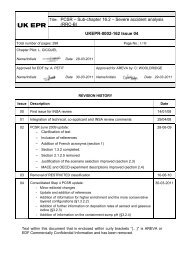Level 3 PSA - EDF Hinkley Point
Level 3 PSA - EDF Hinkley Point
Level 3 PSA - EDF Hinkley Point
Create successful ePaper yourself
Turn your PDF publications into a flip-book with our unique Google optimized e-Paper software.
HPC-NNBOSL-U0-000-RES-000028 Version 1.0<br />
<strong>Level</strong> 3 <strong>PSA</strong><br />
NOT PROTECTIVELY MARKED<br />
end states used in this analysis is presented in Table 13. The information is taken from<br />
the March 2011 GDA PCSR Sub-chapter 15.5 [Ref. 3] and the HPC PCSR2 <strong>PSA</strong><br />
Update [Ref. 11], the <strong>PSA</strong> update included a refinement of the <strong>Level</strong> 1 <strong>PSA</strong> Success<br />
Sequence Definitions given in the March 2011 GDA PCSR.<br />
In general, the end state allocation is based upon the deterministic safety requirements<br />
of the Flamanville 3 (FA3) <strong>PSA</strong>R. In particular, the upper limit of 10% cladding failure<br />
corresponds to the maximum amount of clad failure expected for non-core damage<br />
events in the FA3 <strong>PSA</strong>R.<br />
By applying the above process, the following end states are allocated:<br />
<br />
<br />
<br />
<br />
Transients:<br />
o T is applied for transients where no cladding failure is expected<br />
o TF is applied for transients where 10% cladding failure is expected<br />
LOCAs:<br />
o L is applied in case of LOCA inside containment without cladding failure<br />
o L-FB is applied in case of primary leak due to Feed and Bleed operation<br />
without cladding failure<br />
o LF is applied in case of LOCA inside containment with 10% cladding failure<br />
o LF-FB is applied in case of primary leak due to Feed and Bleed operation with<br />
10% cladding failure<br />
o LF1 is applied in case of LOCA inside containment with 1% cladding failure<br />
ISLOCAs:<br />
o V1 is applied if automatic isolation is successful (i.e. if there is a limited release<br />
of coolant).<br />
o U1 is applied in case of Uncontrolled <strong>Level</strong> Drop with automatic Chemical and<br />
Volume Control System (RCV [CVCS]) isolation<br />
o V2 is applied if the break is isolated manually (i.e. there is potentially a large<br />
release of coolant).<br />
o U2 is applied in case of Uncontrolled <strong>Level</strong> Drop with manual RCV [CVCS]<br />
isolation<br />
Success sequences for ISLOCAs are considered only for shutdown reactor states<br />
and when there is no core uncovery, therefore no cladding failure is expected.<br />
SGTRs:<br />
o PI is applied where the affected SG is isolated<br />
o PN is applied where the affected SG is not isolated<br />
No cladding failure is expected for success sequences.<br />
3.3.1.2 Source Term and Dose Band Identification<br />
For each of the end states defined above and shown in Table 13, the potential fission<br />
product pathway is modelled using non core damage event trees. The following barriers<br />
to a release are modelled in these event trees:<br />
<br />
Containment isolation<br />
UNCONTROLLED WHEN PRINTED<br />
NOT PROTECTIVELY MARKED<br />
Page 12 of 60














![6.3 - Safety Injection System (RIS [SIS]) - EDF Hinkley Point](https://img.yumpu.com/42739985/1/184x260/63-safety-injection-system-ris-sis-edf-hinkley-point.jpg?quality=85)


